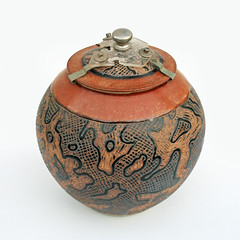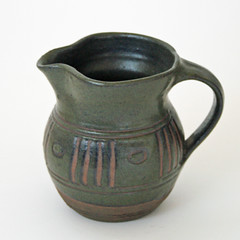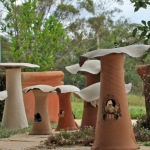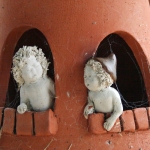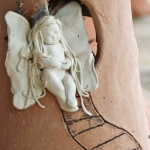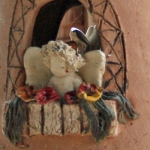This wheel-thrown high-sided bowl was made at the Yarrabah Pottery in Far North Queensland in 1979. It has a pale grey glaze with white slip partially obscuring oxided sgraffito drawings of two crocodiles separated by panels of abstract Aboriginal motifs. While the glaze is a little thinly applied in places, I’ve grown to like this bowl during the time it has spent on the workroom table. An albino crocodile is said to guard a waterhole sacred to the Gunganji people of Yarrabah [1] and the two crocodiles seem to float in a watery dreamtime space.
Yarrabah Pottery was established in 1973 at the Yarrabah Mission (now the Yarrabah Aboriginal Community), 30 km south-east of Cairns as the crow flies. Like the Barambah Pottery at Cherbourg founded in 1969, it was an initiative of the Queensland government to provide sustainable employment opportunities for mission residents [2]. In 1972, Ray Harrison (1937- ) was appointed the first teacher and manager. A graduate of Shepparton Technical College and of Toorak Technical Teachers College, he moved to Queensland in 1969, setting up a studio near Cairns and teaching at Cherbourg first, before spending three-and-a-half years at Yarrabah from 1972 [3]
One of the first apprentices there was Edward (Edwin) Deemera (1959- ). He started by learning to mix and recycle clay, then moved from handbuilding to throwing and finally to production line work, making a range of functional ware [4]. In the early years of operation, work made at both Cherbourg and Yarrabah was sold through the front window store of the Department of Aboriginal and Islanders Advancement (DAIA) in Brisbane. Ranges were designed to meet the whims of the tourist market, with very little freedom for potters to develop their own styles [5].
Our bowl was made after Harrison had left but while the pottery was still being managed by white Australian teachers and mentors. Its maker, ‘GD’, is Gwen Deemera, sister of Edwin, who was still at Yarrabah when she exhibited hand built pots at the Cairns Potters Club Biennial National Ceramic Exhibition in 2011 [6].
In 1986, the Yarrabah Pottery was featured in a Special Queensland Edition of Pottery in Australia [7]. The manager at that time was Peter Faulkes and working there with Deemera were Heather Koowootha and Cornelius (Connie) Richards (1964- ). The aim was eventually to enable the community to run the pottery independently. This happened in 1990, the start date on the pottery’s current website [8], and I am assuming that it is around the same time that it became known as the Yarrabah Guyala (Seahawk) Pottery.
Twelve years later in 2002, Richards was working as the master potter there and Deemera as his assistant when the Yarrabah artists were moved from a tin shed to a new purpose-built art, craft and cultural centre funded jointly by the State and Local Government through ATSIC’s Community Development Employment Program [9].
Rummaging through boxes, I found that we have two other Yarrabah Pottery pieces, both made by Richards – a port keg decorated with a carved fish in a deeper red colour and a vase decorated with a carved turtle in shades of dark blue and maroon.
This use of functional ware to record the legends associated with the Yarrabah landscape is characteristic of the Yarrabah Pottery work that I’ve seen so far. Participating in the 2001 “Gatherings, Contemporary Aboriginal and Torres Strait Islander Art from Queensland, Australia” exhibition held in Brisbane and in the 2003 “Storyplace” exhibition at the Queensland Art Gallery, Richards wrote “My main goal is to put culture and history on some of my works using traditional names and telling the stories of long ago” [10].
The website (which may not be entirely current) says that two full-time potters and five part-timers work there. The pottery was also receiving support from teachers at the Indigenous Faculty of the Tropical Far North Queensland College of TAFE in 2003 [11]. Other potters associated with Yarrabah include Chris Harris, whose work also features indigenous motifs and themes [12], and Michelle Yeatman, who exhibited large coil pots influenced by Thancoupie at the Cairns Indigenous Art Fair in 2012[13].
It is hard to encapsulate forty years of ceramic practice from the scant published record and a few examples but it seems to me that over this time the Yarrabah pottery has developed a strong creative spirit and sense of place from its industrial beginnings. While individual potters have come and gone there is now a history there of making ceramics that is facilitating the emergence of younger potters like Michelle Yeatman as part of a wider community of Yarrabah artists.
Notes
- Suzanne Gibson, “Albino crocodile – croc bites“, ABC Far North Queensland, 18 September 2003 (Intenet Archive copy).
- Lone White, Three decades of ceramics in far north Queensland : an informal history of the Cairns Potters Club, Cairns, Qld. : Cairns Potters Club, 2004, p.6.
- Sue Herbert, “Ray Harrison”, Pottery in Australia, vol.22, no.1, p.68-69.
- [Edward Deemera] Pot, Queensland Museum, Aboriginal Studies Collection, QE11792.
- Kevin Grealy, “Barambah Pottery, Cherbourg”, Pottery in Australia, vol.16, no.2, Spring 1977, pp. 3-7.
- “Gwen Deemera. Hand built pots” in Cairns Potters Club, Melting Pot: 10th Biennial National Ceramic Exhibition, Cairns Regional Gallery 29 July – 18 Sep 2011.
- Connie Hoedt and Hilary O’Leary, “Yarrabah Pottery” in “A history of pottery in north Queensland”, Pottery in Australia, vol.25, no.1, 1986, p.63.
- “Yarrabah Pottery”, Yarrabah Aboriginal Community website.
- Alf Wilson, “Yarrabah artists on the move”, Koori Mail, 287, 16 Oct 2002, p.37.
- “Cornelius Richards b.1964. Biography“, Design and Art Australia Online.
- Adrian Newstead, “A survey of Australian indigenous ceramic art”, Ceramics: Art and Perception, 52, 2003, p. 36.
- “Ceramics made by Chris Harris of Yarrabah”, image illustratingQueensland Museum. Cultures & Histories collections.
- “Yarrabah artists were a hit at CIAF“, Cairns Indigenous Art Fair Newsletter, Sep 2012.
